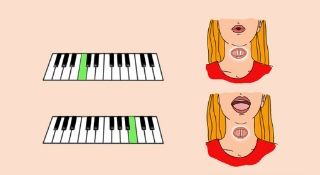How To Sing Without Vocal Tension
One of the most important things you can do as a singer is learn how to sing without vocal tension.
Have you ever felt that when you where singing you were straining to hit certain notes?
Or have you noticed that after singing your voice felt sore and strained?
These problems stem from singing with too much tension.
In a moment I’ll share some tips that will help you lift this tension from your voice, so you can sing with wonderful freedom.
And in doing this, singing will become much more enjoyable! Also, your voice will sound better too, because tension means that something physically is restricting you.
It means that your tone is being blocked… and once you remove this blockage your voice will be freed up to sound it’s best.
Now there can be a lot of difference factors that can cause you to feel tension when you sing.
Watch this video where I give you an explanation about where vocal tension comes from - as well as give you an exercise that will take the strain off of your voice.
The Secret To Star Singing
Click HERE For The Secret To Star Singing
The Secret To Star Singing
Click HERE For The Secret To Star Singing
Let’s look at the most common factor that causes tension when you sing.
#1 Reason For Vocal Strain - You’re Cutting Off Your Air When You Sing
It’s very common that you are cutting off your air supply as you’re trying to create sound. And to compensate for this, to attempt to get your sound to come through, you tighten up!
You strain and push to try and hit your note. This is a recipe for singing with too much tension!
So what we need to do if this is happening with you is to try and get that vocal tension to release.
To do this, let’s look at how the body works when you are straining.
Here’s Where The Vocal Tension Comes From
Typically when you are straining it means you are using the muscles in the outside of your neck.
These outside muscles are connected to your larynx, otherwise known as your voice box. It’s in your voice box where your vocal chords are which are responsible for creating your sound.
So here’s the sequence that’s happening here:
- When you go for a more difficult note (usually your higher notes!) these outside muscles in your neck are tightening.
- Because these muscles are connected to your voice box, they move it out of place.
- When your voice box is not in it’s normal position, it cuts off your air supply.
- When you don’t feel like you have enough air, you will naturally tighten up and push even harder to try and get the note.
This Sequence Adds Up To Uncomfortable Vocal Tension!
So the key to putting a stop to this sequence of events is to release these neck muscles. If you can keep them relaxed as you sing, the voice box will stay in the correct place.
And your air supply will no longer be cut off. This means you’ll have all the air you need to sing and you’ll no longer need to push and put unneeded strain on your voice.
Let’s Do An Exercise That Will Help You Release The Tension From Your Voice
The exercise we are going to use is an “AAAA” sound on a simple scale.
Watch this video to see a demonstration (The video will begin at the correct place for the demonstration at 3:39)
And here’s the audio file used in the video so you can practice the exercise.
With this exercise there are two important instructions to follow:
1. The first thing is to try to not push up to the note that you’re trying to sing. As soon as you feel yourself push to get a note, stop the exercise and start again trying to stop any pushing.
2. The second thing is to use the mental idea that your vocal chords are adjusting to get the different notes. So just visualise that your tiny little chords in your voice box are making adjustments as you sing, and them alone are determining the note you are trying to hit.
Another helpful tip is to have the idea that as you sing up into the high note in the scale that you are “letting go”. If you watch the video demonstration you’ll be able to get a sense of this.
Using the idea that you’re “letting go” will help your vocal chords change in the way that they are supposed to.
If You’ve Been Singing With A Lot Of Vocal Tension
If you’ve developed some habits over the years that have you singing with a lot of tension, you may not be able to hear if you’re hitting the correct note or not.
So, an effective tip that will help you with this is to try to listen to your voice in the middle of your forehead. If you focus your hearing in this way you’ll develop the ability to really clearly hear what your voice is doing.
Another Tip That Will Help If You Want To Sing Higher Notes
Another idea that will help remove tension from your voice is this:
As you sing higher, back off the sound.
This means using less air as you sing higher.
The reason this will help you is to get a higher note, your vocal chords get smaller. So you don’t need as much air to get your higher notes.
By using less sound or less air as you sing higher will give your body the chance to relax. And this in turn will allow the vocal chords to make the changes they need to to get the right note.
As The Restrictions Fall Away…
The thing you will notice as the outside muscles start to relax and the restrictions fall away, is you’ll gain more and more vocal range.
This is also a sign that your vocal technique is improving.
Be Patient, Good Things Take Time
It’s important to be gentle and patient with your voice. This is something that might take a little time to master. This is particularly true if you have picked up some bad habits over the years.
So do a little bit of this exercise each day or two. Don’t worry too much about how fast you are progressing. I promise you that as long as you stick with it, you will be able to take all of the strain off of your voice and find freedom in your voice.
I hope you’ve enjoyed this tutorial on how you can sing without vocal tension. Please let me know any question you have below in the comments section.
And above all, have fun with your singing!
About The Author
 Roger Burnley - Vocal Coach Roger Burnley - Vocal Coach |
Roger Burnley is a vocal coach located in Hollywood, California. He has been teaching singers for over 30 years and singing for even longer than that.
Notable past and present clients include Macy Gray, Brandy, Ray J, The Beastie Boys, James Torme, Taylor Lautner, Nona Gaye, and many more.
His clients have collectively sold more than 30 million albums, with several reaching Platinum and Gold status.
Roger has been featured on VH1, TV Guide Channel, TV One,
and MTV appearing as a vocal expert.
About The Author
 Roger Burnley - Vocal Coach Roger Burnley - Vocal Coach |
Roger Burnley is a vocal coach located in Hollywood, California. He has been teaching singers for over 30 years and singing for even longer than that.
Notable past and present clients include Macy Gray, Brandy, Ray J, The Beastie Boys, James Torme, Taylor Lautner, Nona Gaye, and many more.
His clients have collectively sold more than 30 million albums, with several reaching Platinum and Gold status.
Roger has been featured on VH1, TV Guide Channel, TV One,
and MTV appearing as a vocal expert.









New! Comments
Show me you're alive! Leave a comment below...